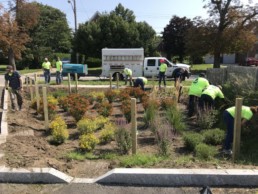Engaging the Community in Green Infrastructure
Year Complete: 2015
Grant Amount: $85,000
Local Government: Buffalo Sewer Authority
Local Foundation: Community Foundation for Greater Buffalo
Project Purpose
To conduct a public education and engagement campaign around storm water management and green infrastructure projects taking place in the City of Buffalo.
Key Lessons Learned
Lessons learned about tools and tactics through the project that other sustainability directors could use to advance their work.
Focus groups and survey respondents made clear the need for more transparency around roles of partners and available programs. In particular, respondents showed a significantly higher level of confusion in trying to define what municipal partners offered versus community-based partners. Interestingly, a large percentage of suggested activities were already provided by the Buffalo Sewer Authority, but the internal culture steered away from publicity and as a result many services offered were unknown to residents.
Residents also wanted to see short-term intentional action. Planning fatigue was a significant challenge in Buffalo, so the partners recognized the need for a “quick win.” Residents needed to be assured that small actions do add up and assist with the larger effort at hand.
Lessons for developing a collaborative process between a local government sustainability director and local place-based foundation(s).
Good market research and public engagement should drive the planning and implementation of projects intended to inform and motivate the community. Any institution—public or private–must plan enough time to craft RFPs and interview consultants, conduct the engagement, analyze the results, and set priorities. Having good information about public understanding is well worth the time it takes to collect and analyze quality data.
The team learned that it is important to clearly define roles, responsibilities, and processes as early as possible in the collaborative process. Specifically, the differing levels of review and expectations of who would be involved at each partner site created some challenges keeping to the timeline. In the end, it was more important to make sure that all stakeholders were comfortable than to rigidly manage the timeline of the project. With an increased level of trust between partners and understanding of the work, the team created a more streamlined process.
Additional Information and Resources
The first major initiative from this project, the Rain Check Downspout Disconnect and Rain Barrel program, was announced in 2015. Since then, over 400 rain barrels have been installed throughout Buffalo, giving an overall capacity of over 50,000 gallons.

